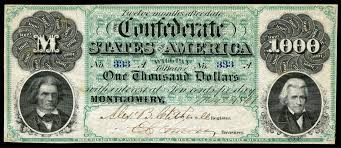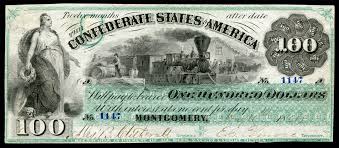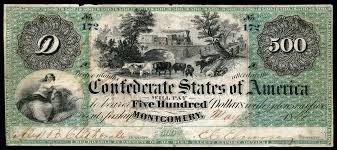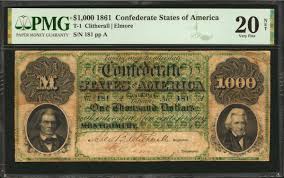Confederate currency, long considered a relic of America’s Civil War era, is now emerging as a sought-after treasure for collectors. Some of these historic notes—particularly those issued in 1861—have fetched as much as $35,000 at recent auctions, depending on rarity, condition, and historical significance.
If you’ve come across old paper money passed down through generations, it may be worth checking if you hold one of these valuable notes. Below are seven Confederate bills that are attracting the attention of collectors and investors alike.
1. 1861 T-1 $1,000 Confederate Note
One of the most sought-after bills is the 1861 T-1 $1,000 note, which features portraits of John C. Calhoun and Andrew Jackson. Only 607 of these notes were issued, making them extremely rare. An uncirculated specimen was recently appraised at approximately $35,000, according to Investopedia.

2. 1861 T-3 $100 Confederate Note
Known for its historical context, the T-3 $100 note was part of a shipment from New York City that was intercepted by Union forces, cutting off further production. A note graded PMG 63 Choice Uncirculated is estimated to be worth upwards of $35,000, as reported by Numismatic News.

3. 1861 T-2 $500 Confederate Note
Printed by the National Bank Note Co., this note features a train vignette and the Roman goddess Ceres. One example graded PMG 20 Very Fine was recently valued at $25,000 or more. Its appeal lies in both its rarity and artwork.

4. 1861 T-1 $1,000 Note – PMG 20 Grade
A different grading of the T-1 note, this version is one of only 25 recorded examples. Despite being in PMG 20 Very Fine NET condition, its estimated auction value still exceeds $25,000.

5. 1864 T-67 $20 Confederate Note
While not as valuable as the others on this list, well-preserved versions of the T-67 $20 note featuring the Virginia State Capitol can be worth a few thousand dollars. These notes are more common, but high-grade examples still hold collectible appeal.
6. 1862 T-39 $100 Train Note
This bill, part of the “train note” series, features a steam locomotive and is prized for its vivid imagery. Prices vary, but rare serial numbers or high condition notes can fetch over $10,000.
7. 1863 T-59 $10 Confederate Note
Featuring a field artillery scene, the T-59 note is a mid-tier collectible. While not in the $35,000 range, exceptional versions have sold for up to $5,000, especially when paired with authentic war-time documentation.
Why These Notes Are Worth So Much
The value of Confederate notes largely depends on three factors:
- Rarity: Many notes had very limited print runs and were quickly withdrawn or destroyed.
- Condition: Uncirculated or minimally worn notes command the highest premiums.
- Historical Relevance: Notes linked to famous events, locations, or intercepted shipments (like the T-3 $100) are particularly valuable.
What to Watch Out For
Collectors should be aware of counterfeits and reproduction Confederate currency, which are common due to the popularity of Civil War memorabilia. To ensure authenticity:
- Consult professional graders like PMG (Paper Money Guaranty).
- Work with established dealers listed through the American Numismatic Association (money.org).
- Research historical notes via educational resources like the Smithsonian’s National Museum of American History.
For current valuations, check auction results on reputable sites such as Heritage Auctions or Stack’s Bowers Galleries.
Should You Sell or Hold?
Given their rising value, high-grade Confederate notes have become investment-grade assets. Still, selling decisions should consider:
- Market timing: Coin and currency markets fluctuate.
- Collector demand: Rare denominations tend to appreciate over time.
- Sentimental value: For many families, these notes also carry historical legacy.
Final Thoughts
Whether you’re a history buff or casual collector, holding a rare Confederate bill might just be your ticket to a substantial payout. With some notes reaching over $35,000, it’s worth getting your paper currency appraised by an expert. Just make sure you’re not holding a replica—unless you enjoy the look of Confederate history rather than the investment.
This article has been carefully fact-checked by our editorial team to ensure accuracy and eliminate any misleading information. We are committed to maintaining the highest standards of integrity in our content.



